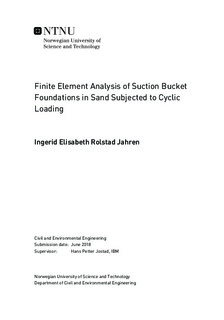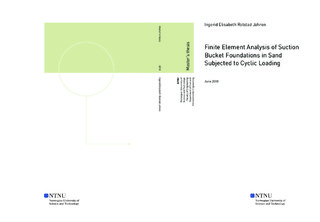| dc.description.abstract | A suction bucket or suction caisson is a foundation concept for supporting offshore installations. The practical experience related to this concept is mainly based on applications in the oil and gas industry. Observations show significant difference in response for wind turbines compared to more traditional installations offshore. The lightweight structure of a wind turbine makes the caisson susceptible to cyclic loading due to metocean conditions. As this foundation concept is being increasingly considered for offshore wind turbines, a proper understanding of its behaviour is important for a functional and effective design of suction caissons for this purpose.
A series of centrifuge experiments have been performed at the University of Western Australia
to investigate the response of a suction caisson in dense Baskarp sand. The experiments aim to represent the load conditions of a caisson supporting an offshore wind turbine in the North Sea. Raw data from the centrifuge experiments have in this thesis been analysed focusing on the cyclic response, and the work demonstrates a significant difference in response for compression and tension loading. The permeability of the soil is also found to be decisive for the caisson response.
A model of the centrifuge experiment in prototype scale is in this study recreated in the finite element software PLAXIS. Model parameters are based on tests on similar sand available at NGI, due to limitations of sand specific cyclic laboratory tests related to the centrifuge experiments. Arbitrary sets of parameters, representing sands of different densities, are also considered. Loads identical to those of the centrifuge experiments is applied to the simulations.
Results from the simulations differ from the centrifuge experiments. Displacements are in general underestimated and total stress and pore pressure are overestimated. Several reasons to the differences are discussed in the thesis, and these are assumed to be related to calibration of the permeability, loosening of the sand due to installation, lack of fully contact between caisson lid and soil in addition to air bubbles in the pore fluid. The differences emphasise the challenge of capturing all features of the complex caisson response in a simplified model. | |

